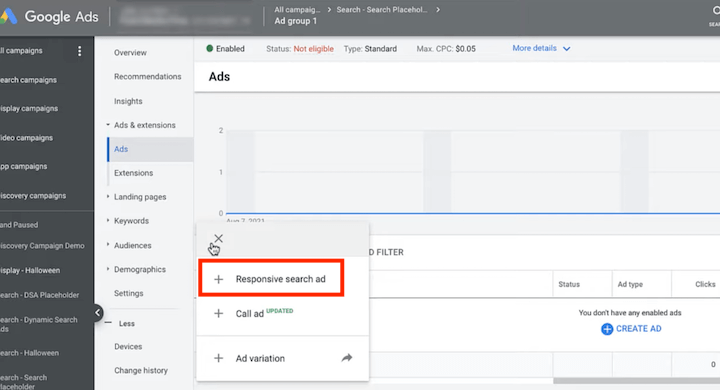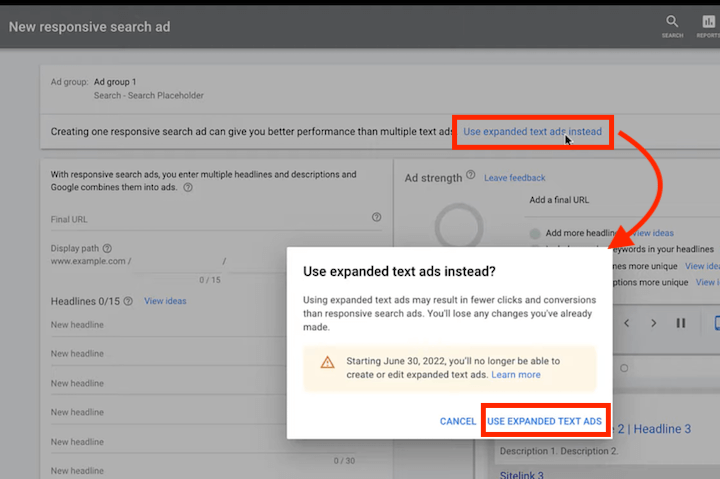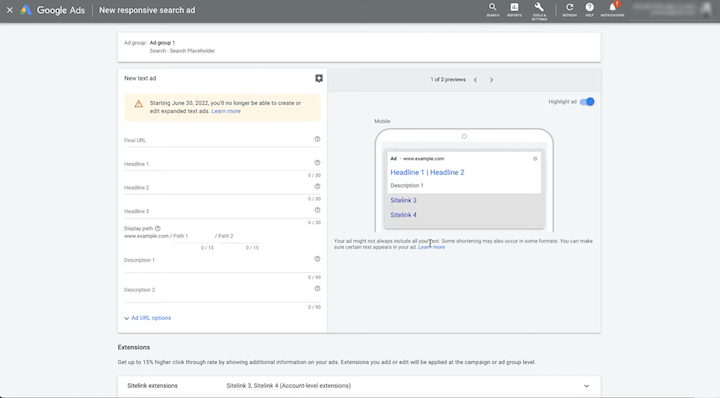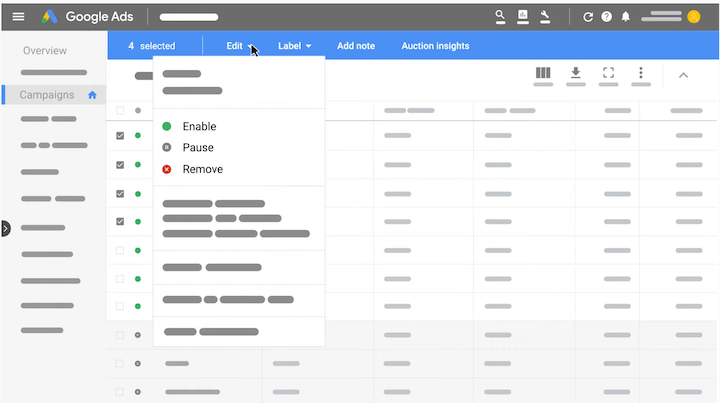Easy Way to Convert Adwords Ads to Expanded Text Ads
Back in the fall, both Google and Microsoft announced that expanded text ads will be sunset starting June 30, 2022 and that responsive search ads will be the only standard search campaign you can create moving forward.
So you can put the kibosh on your ETAs, right?
Wrong!
Okay, well you can just hang tight until June, right?
Wrong again!
There are actually several important things you should be doing now—with both your ETAs and RSAs— so your account doesn't take a nosedive come June:
- Test expanded text ads now
- Set up new ETAs for future use
- Prepare for declining impressions
- Start using responsive search ads now
- Establish RSA benchmarks
- Pin strategically
- Understand RSA reporting limitations
Let's get started.
1. Test ETA message combinations while you still can
If you've been interested in running a specific ad copy test but haven't gotten around to it yet…now is your time.
Prioritize ad messaging and get ETAs in place now—while you can see all the performance metrics at a granular level—to determine which headlines, descriptions, and combinations work best.
To create an expanded text ad, proceed as if you were creating a new responsive search ad.

Once you get to the responsive search ad setup window, select "Use expanded text ads instead" and then select the option again when the warning pops up.

You'll then be brought to the expanded text ad creation window you've called home for so long.

For help with ad copy and testing, check out these posts:
- 6 A/B Tests Where Small Word Changes Made a BIG Difference
- The 5 Mistakes You're Making in Your Google Ad Copy
- 7 Ways to Write Super Effective Google Ads Copy
2. Create staged ETAs to use later
On June 30 of 2022, you will no longer be able to create new or edit existing expanded text ads…BUT existing expanded text ads will continue running and can be turned on/off as desired.
So with that in mind, I suggest you create as many expanded text ad combinations in your account that you believe you will reasonably use in the future. They can be paused to start, but remain waiting for a future test. This way, you retain the ability to use them since they were already created and all you have to do is turn them on and off.
But be realistic
You'll notice I said, "that you believe you will reasonably use in the future." That's important. As in, don't create and upload every single ad iteration you can possibly think of and then come back to me in a year and shake an angry fist at me for suggesting you bulk up your campaigns. That's not my goal.
Think critically about which ad variants are important to you to test in the future and upload only the ones that you are confident you'll use. There's no need to upload 500 ad variants per ad group if you only test three new ad variants a quarter. Be realistic with this step, but don't pass up on the opportunity to create the ad variants you want.
3. Be ready for declining ETA impressions
Although I think it's important to take advantage of ETAs while we have them, I'm also realistic.
Even before this change was announced, we were seeing declining impression counts on expanded text ads compared to responsive search ads in many accounts. My hunch is that trend will continue.
Test as many messages as you can, stage creatives for future tests, but have the expectation that as we get closer to and past the June deadline, RSAs will likely continue to take an increasing percentage of impressions away from ETAs.

4. Activate responsive search ads now
Google's standard suggestion is that you have at least one responsive search ad active in every ad group of your account.
At this point, I'm on board with them.
Unfortunately, whether we like it or not, RSAs are going to be the new norm within all Google Ads accounts, so it's in everyone's best interest that you start getting used to them now. The longer you hold out, the more you're going to be struggling once the deadline hits.
If you aren't familiar with them, head to this post: Responsive Search Ads 101: Best Practices You Need to Know.
5. Establish RSA benchmarks
RSAs nearly always have a higher click-through rate than ETAs. (Notice I said "nearly always." Don't @ me with your exceptions.)
Conversion performance, on the other hand, varies widely. Some accounts do very well with responsive search ads and others can really struggle when it comes to getting customers over the final finish line.
Get RSAs active in all ad groups of all search campaigns in all of your accounts now so you can start establishing benchmarks for each specific account. This will be very, very handy when you have to answer to your boss or client about changes in performance.
We began testing a new ad format that is going to be the default moving forward. Rather than giving you generic benchmarks, we tested these in your account specifically and here is the range that we can expect moving forward.
Even if the benchmarks are lower than previous performance, I can guarantee you'll soften the blow by establishing clear expectations early on. This is the key to building client relationships that last.
6. Pin strategically
One feature of responsive search ads is the option to pin certain headlines and descriptions in place. Note that ads will still always be two headlines and one description at a minimum, with the option for Google to extend them to three headlines and two descriptions, but ads will never be longer than that. Here are some important tips with regard to this functionality.
Use pinning to ensure a CTA in every ad
Not every headline and/or description needs to have a call to action included, but every ad, of course, should. Pin certain components to ensure that every ad variant that's eligible will contain a call to action.
Pin multiple components to the same position
If you have a few headline variants that are fairly similar, you can pin them all to the same position. As a result, only that group of headlines will show in that position and not anywhere else. This is a great way to treat call to action headlines. You can create four different CTA headlines and pin them all in position two so that placement will always contain one of those four CTA headlines.
Either pin everything or leave gaps
If you have elements pinned to all five ad positions and then also have elements that are not pinned, those unpinned elements will not show. To prevent this, either pin all ad components to a placement or be sure to leave some headlines/descriptions open for Google to dynamically create ad copy for you.
If all of this feels confusing, don't worry—you're not alone. You might find our responsive search ad copy template helpful for this.
Understand how ad strength works
Ad strength is NOT to be confused with Ad Rank or Quality Score. The ad strength score within Google Ads is designed to give you guidance on seeing better results from RSAs, but it doesn't impact how often your ad will enter the auction. If you have nosy clients or managers that are regularly in accounts who will pay attention to this, be sure they understand how this metric works. Google explains ad strength here.
Image source
Make ETAs with the RSA framework
Responsive search ads only require three headlines and two descriptions to be added to a campaign and run. You can also pin elements wherever you like within your RSAs.
Ergo…you can basically make an expanded text ad by creating responsive search ads with minimal ad components and pinning them all in place.
Be careful with this
Although this might seem like an appealing option and one that might make sense for users with legal requirements or disclosures, I don't suggest it for everyone. In the long run, Google Ads is only going to further automate your ad campaigns. The sooner you're able to adapt and lean into its machine learning to see better results rather than maintain a tight chokehold, the better off you'll be.
There really are quite a few ways you can customize RSAs to be exactly what you want/need them to be if you take the time to set them up properly.
7. Understand RSA reporting limitations
The reporting for RSAs is also a bit different than ETAs. We're still able to see the performance at an ad unit level for all the metrics we would want to see. But if you're leveraging any level of dynamic ad serving, you'll likely not be able to get an exact picture of which ad combination generated results.
In the image above, you can see the performance for each ad unit, but since the responsive search ad is leveraging dynamic headlines and descriptions, we're not totally sure which combinations created the performance.
View asset details
By clicking on the "View Asset Details" link below the ad, you can get further insights into performance.
Unfortunately, these further details are very lackluster and don't always provide the full insights we would like. You'll notice that all stats are removed aside from impressions. So although you can tell which components were shown the most, you won't actually know which ones assisted in each aspect of the ad's performance.
Get a true read on your performance with our Free Google Ads Performance Grader.
Asset performance rating
Additionally, you'll notice Google has an asset performance rating system:
- Pending: No information on the asset yet.
- Learning: Not enough information on the asset yet.
- Low: One of the lowest performing of its type. May want to replace.
- Good: Performing well relative to other assets of its type. Keep and add more.
- Best: One of the best of its type. Keep and add more.
- Unrated ("—"): Rating not available due to insufficient activity, traffic, or number of similar assets to compare against.
These are…pretty unhelpful if you ask me. But they do give some indicator on what Google is seeing performance-wise for each component.
The important thing about these scores is they DO NOT correlate directly to conversion performance. Just because a component is rated Best, it doesn't mean it's generating conversions. To find that out, you'll need to pin some ad components in place and get more firm data.
Check the Combinations tab
Lastly, you can see some ad combinations by clicking on the Combinations tab up at the top of the asset details page.
Similar to the other page, you'll still only see an impression count, but depending on how evenly your combinations are being shown, you may be able to infer which variants are driving the performance your ads are seeing.
Be ready for the sunsetting of expanded text ads
Whether you're upset or indifferent about the change, it's important to take advantage of the time that you have before the deadline to ensure your account is in as strong of a position as it can be. Whether you focus more on ETAs or RSAs will depend on what you currently have active in your account.
All in all, fight the urge to hold onto your control too tightly by pinning components in all areas or limiting dynamic learning, but don't accept all "best practices" from Google as the best option for your account. Use this time to test, learn, and iterate, and you'll be ahead of your competition when the rollout is complete.
You may also be interested in these5 Ways to Use Responsive Search Ads to Maximize Your ROI.
Source: https://www.wordstream.com/blog/ws/2021/11/02/responsive-search-ad-tips









0 Response to "Easy Way to Convert Adwords Ads to Expanded Text Ads"
Post a Comment